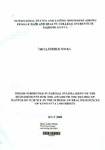| dc.description.abstract | Eating disorders among young females are on the increase. Body image concerns are more prevalent in females than males; hence eating disorders are also more prevalent in females than males. Many college females are struggling with the idea of weight loss or gain to meet the perfect standard and yet they lack laid down procedures on how to do it thus resorting to harmful methods. It is in this light that this study was designed. The purpose of this study was to investigate the nutritional status and socio-behavioral factors that influence disordered eating habits among female hair and beauty college students in Nairobi, Kenya. The objectives of the study were to assesethe nutritional status of female college students, determine the prevalence of eating disorders, and determine the risk factors associated with eating disorders. The study was carried out in Nairobi. The target population was females attending hair and beauty colleges in Nairobi, aged 18- 26 years. The study involved 219 respondents. Data were collected using questionnaires. Nutritional status was determined by computing the BMI of the respondents and also looking at consumption of various foods over a given period of time. Quantitative data were analysed using (SPSS) programme. To determine the nutritional status anthropometric data were analyzed using Epi Info to compute Body Mass Index. The Eating Attitudes Test was used to measure disordered eating behaviors. Cut off points for physical activities were chosen in a manner consistent with the national health objectives and recommendations. Eighty two percent of the respondents reported normal eating habits while 18% reported abnormal eating habits. Six percent of the respondents were underweight, 60.5% were of normal weight, 24.7% were overweight and 8.8% were obese. It was noted that most of the respondents were exercising for longer periods than recommended by the National Health Objectives' and Recommendations for physical activity. There was a significant relationship pS 0.05 between peer support and development of eating disorders. There was also a significant relationship pS 0;05 between eating disorders and the kind of family one came from. Reading of magazines and television watching had no influence on food issues. There was no significant relationship between nutrition status and eating habits at pS 0.05 significance levels, though contingency coefficient measure of association showed that nutrition status accounted for 23 percent of the observed variations in eating habits. Conclusion; Young females in beauty colleges are engaging in disordered eating habits that may be harmful to their health. It was therefore recommended that nutritionists should offer nutrition education to young females on the dangers of engaging in disordered eating habits and nutrition education should be strengthened in the curriculum that is used in the beauty colleges for change to be realized. | en_US |

